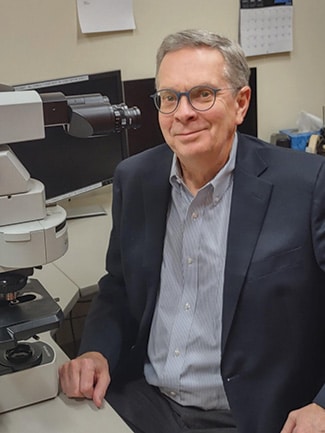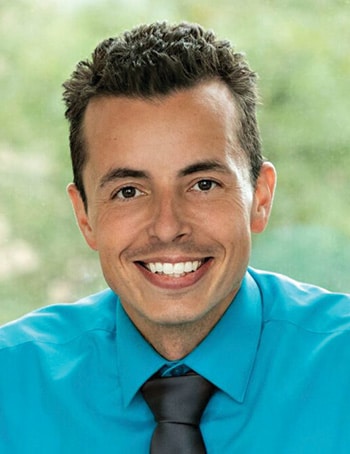Valerie Neff Newitt
February 2024—Efficiency can be hard to measure. But Kenneth Batts, MD, of Hospital Pathology Associates in Minneapolis, which contracts with Allina Health to provide anatomic pathology coverage, is sure that a pathology aide program the group started long ago makes its pathologists far more efficient.
“It seems very likely we would have more than our current number of pathologists and/or we would be working longer hours if the pathology aide program were to be discontinued,” he says.
Even the training of the pathology aides, who sign on to work for one year, is efficient: “Our incoming staff are trained by the outgoing staff,” says Brandon Peterson, pathology support services supervisor, who oversees the program, including the training.
The program got its start in 2010, when it looked to the group’s pathologists like more pathologists needed to be hired. “The recurring question,” Dr. Batts recalls, “was if we could each become just five percent more efficient, would we still need to hire additional pathologists?”
They looked closely and critically from a Lean perspective at what they were doing daily. “And it became clear that much of what kept us busy was work that did not require a pathologist, and in many cases did not require any significant medical background,” he says.
The work they identified as worthy of offloading included, among other things, having to sift through new cases rather than have them delivered to their offices, matching cases to skill sets, moving cases within the group when pathologists were not on the Abbott Northwestern Hospital campus where the group works, retrieving old slides for review, obtaining histories and operative notes in the health record or in places not on the main information system, and managing and preparing for intra- and interdisciplinary conferences.
“We did have residents at the time but thought much of this work was not productive for them either,” Dr. Batts says.
A job description for a pathology aide was created, calling for “energy and some medical background,” Dr. Batts says. Applicants were few, and the first hire was overwhelmed by the job duties and quit after one day.
A medical technologist in the department had a nephew who had completed his pre-med undergraduate studies and was looking for practical medical exposure. It was this aide, Daniel Larson, who got “the pathology aide program off the ground after our rocky start,” Dr. Batts says, adding, “He parlayed his experience as a pathology aide into medical school acceptance and he is now a staff pathologist at Mayo Clinic.”
The experience with Dan convinced the group’s pathologists that looking for recent pre-med graduates who want gap year experience were the “best source,” Dr. Batts says. “They are of high quality and eager to please and accumulate recommendation letters.” He contacted pre-med advisors at eight to 10 colleges in the region, and the number of applicants far outpaced the number of positions.

About 24 applicants for the pathology support staff positions will be at this year’s recruitment session. Says Dr. Batts (above), “We have found the outgoing class of pathology aides to be invaluable in sifting through the candidates and assessing who will be the best to do the job.”
Now, years later, the job postings are sent every December to colleges and universities in the Midwest, and a few months later a Saturday morning session is held to which the best applicants are invited. This year, Peterson says about 24 applicants will be onsite. Three or four pathologists and the outgoing pathology aides participate in the recruitment-interview session, and consensus is used to rank the applicants, many of whom were biology or chemistry majors. Twelve are chosen for the yearlong positions, typically starting in June. “We have found the outgoing class of pathology aides to be invaluable in sifting through the candidates and assessing who will be the best to do the job that’s being handed off,” Dr. Batts says.
Today, the program has grown beyond pathology aides, supervisor Peterson says, to include other jobs “to fill gaps that we identify in the life cycle of an anatomic pathology specimen.”
One such job is an OR runner. Says Peterson: “Several years ago Dr. Schuyler Sanderson, one of our pathologists, noticed that the OR surgical support staff were tasked with delivering specimens and communicating to the laboratory critical information for specimen processing. We saw an opportunity for process improvement and hired two pathology aides to be OR runners, after piloting the system and analyzing the data.” The OR nurses call the number for the runners, who carry phones and can be reached at all times to pick up the specimens. The result: better diagnostic turnaround times and less miscommunication.
“Such a simple concept,” Peterson says. “The OR nurses love it.”
The newest position in what is now known more broadly as a pathology support staff program is the lab technical assistant, who works under the guidance of the histology manager and does accessioning, slide filing, frozen section preparation support, and other tasks. “A direct response to staffing shortages in the histology lab,” Peterson says of the new position.
Biopsy tech is another position: “They augment the pathologists’ assistants in examining our gross specimens.”
The pathology aide position itself has now become three distinct positions, each with a different focus: education, workflow, and quality assurance. The education coordinator pathology aide helps pathologists prepare for tumor boards and other conferences, which previously was a task assigned to lab administrative assistants. “The benefits to our practice are huge,” Peterson says. The workflow pathology aide fills the gap between the histology lab and the pathologists’ offices, organizing cases based on subspecialty, priority, and other requirements.
The QA pathology aide, under the direction of Dr. Sanderson, supports professional competency data collection and reporting for the 39 pathologists in the group. “This person also supports numerous process improvement projects across the practice and provides Allina Health with additional support for data retrieval,” Peterson says.
Over time, says Dr. Batts, “we identified more and more tasks that save pathologists time and increased the number of pathology aides hired per year.” For the benefit of the group and those who have health care careers in their future, Peterson says, “I’m working to grow our applicant pool as our program matures,” which means, for example, attending career fairs to spread the word. Tentative future plans are to expand the program to other locations within Allina Health and to practices outside of Allina Health. “My goals are endless,” Peterson says.
Aides receive competitive compensation and benefits. The biggest competitors are scribe or medical or nursing assistant positions. “So we try to stay competitive with scale of pay,” Dr. Batts says, “but we also offer so much more in terms of learning opportunities. I think we have an advantage.” Peterson agrees: “People love it in terms of meeting physicians and working with them every day in terms of preparing for medical school or professional life in general.”
Outgoing support staff train the incoming staff one-on-one in their respective positions for three weeks. During those transition weeks, Peterson says, “there are a lot of support staff running around as we have the new group and the old group overlapping.” After that, the new staff are on their own, with Peterson on hand for questions.
Though three weeks is sufficient to learn the jobs, the education of the support staff goes further, with pathologist-led sessions in which the staff can see the histology firsthand and learn about cancer staging, tumor types, and more. “We also have grossing sessions with our pathologist assistants where they can see what disease and tumors look like grossly,” Peterson says, as well as shadowing opportunities with autopsy pathologists or even Abbott Northwestern Hospital surgeons. “Those additional experiences enhance their time with us, and by enhancing the experience, we know our staff tend to perform better at their jobs,” Peterson says.

Peterson
The group is now using its pipeline of high-quality applicants to supplement other hard-to-find laboratory staff. “Some are functioning as work expanders in the laboratory,” Peterson says.
Those are just two of the many additional benefits the program brings. “We suspect there is an improvement in quality as matching slides and paperwork go through an extra set of eyes, but this is difficult to quantify,” Dr. Batts says, as are the efficiencies.
The aides’ tech skills are of help too. “Their ability to quietly guide potentially digitally impaired senior pathologists, such as myself, in communication technologies is greatly appreciated and utilized,” he says.
And with pathologist positions hard to fill, “even harder than they were back in the day,” Dr. Batts says, the program seems almost tailor-made for the times. “Surgeons have assistants who help them with a variety of tasks, and this is no different. These are assistants who help with tasks that don’t necessarily need a pathologist and allow us to devote our attention to pathologist-specific tasks.”
“The pathologists work with fewer interruptions as well,” Peterson adds.
Of the aides themselves, Peterson says, “When they leave us to start the next chapter in their educational/professional career, they are more prepared because of what they’ve learned from us.” And the feedback? Judging from an anonymous survey all aides take and the friends of friends who have applied for the positions, “It’s overwhelmingly positive,” he says.
Valerie Neff Newitt is a writer in Audubon, Pa.
 CAP TODAY Pathology/Laboratory Medicine/Laboratory Management
CAP TODAY Pathology/Laboratory Medicine/Laboratory Management
